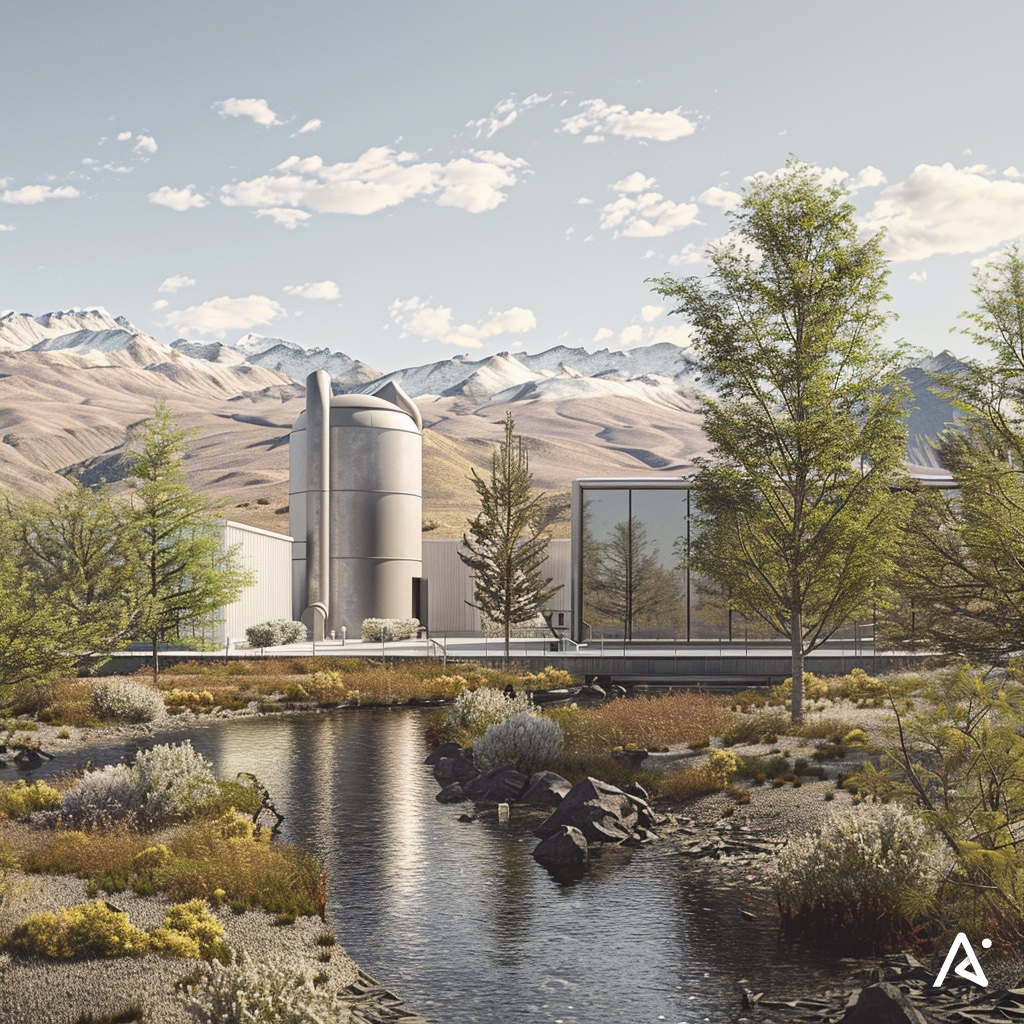
Microreactors, which typically have capacities of less than 50 MW, have been capturing interest in the energy sector as electricity needs climb and companies search for around-the-clock, emissions-free, baseload dispatchable power. (Source: Aalo Atomics)
Austin-based Aalo Atomics is among the startups looking to make nuclear microreactors a reality in the U.S. as electricity demand rises driven in part by data centers.
The U.S. Department of Energy (DOE) in December said it identified a tentative site at Idaho National Laboratory (INL) for Aalo’s experimental microreactor facility. Aalo said it aims to deploy its commercial microreactor design by the end of the decade.
“First, we do some bench-scale tests. The learning from there is going to go into a full scale non-nuclear prototype called Aalo-0, which we’re building right now, and we will test it by the third quarter of this year,” Aalo Atomics CTO Yasir Arafat told Hart Energy. “Learning from that, we’ll go to our first nuclear experimental reactor. That’s the Aalo-X that we’re planning to build at the Idaho National Laboratory. It will be a real reactor with fuel and everything, but it’s going to be an experimental one.”
Aalo has already completed the conceptual design for its 10-megawatt (MW) Aalo-1 sodium-cooled microreactor. The company plans to submit a construction and licensing application for its project next year.
In an emailed statement to Hart Energy, the Nuclear Regulatory Commission (NRC) said it is in early discussions with Aalo about its project at INL. “The INL activities are expected to provide data to support Aalo’s eventual application to the NRC for a license to build and operate a commercial nuclear power plant,” the NRC said.
Microreactors, which typically have capacities of less than 50 MW, have been capturing interest in the energy sector as electricity needs climb and companies search for around-the-clock, emissions-free, baseload dispatchable power. Boasting a smaller footprint compared to traditional nuclear power reactors, microreactors also can be fabricated in factories and transported easily. However, it will be a while before the technology is available.
Currently, there are no microreactors operating or commercially available in the U.S., but startups like Aalo are working to change that with technology development underway.
The path toward commerciality has led many to the DOE’s Idaho National Laboratory, site of the Microreactor Applications Research Validation and Evaluation (MARVEL) project. The project gives researchers insight on the microreactors’ potential role in energy grids and provides a spot for industry partners to quickly test, develop and demonstrate their technologies. As described by the DOE, the MARVEL design is a liquid-metal cooled microreactor with Stirling engines that will produce 100 kilowatts of energy using high-assay, low-enriched uranium (HALEU). Fuel loading for the microreactor, which uses off-the-shelf components and is based on existing technology, is expected to commence in 2026 with the microreactor online by 2027.
Aalo’s 10-MW Aalo-1 reactor is inspired by MARVEL. Arafat previously served as project lead for MARVEL.
“Essentially, what we’re doing is we’re building a commercial-focused version of the MARVEL reactor from Idaho National Lab,” Aalo Atomics CEO Matt Loszak said.

The technology
Aiming to achieve 3 cents per kilowatt-hour electricity, Aalo intends to build microreators in modular plants with data centers being the targeted market. The microreactors will be available in pods. Each pod will contain multiple reactors of 10 MW each, using what Loszak described as an N+1 configuration. That allows the system to continue if one module needs maintenance.
Aalo has sights on building its nuclear reactor plant in Austin.
“The whole plant is very modular. A lot of nuclear companies are doing modular reactors but not modular plants,” Loszak said. “So, we’re trying to do a fully modular plant, everything being modular. And by having that configuration with five reactors and the one extra one, then you can essentially achieve a much higher level of availability. … Because our reactor doesn’t need water for cooling, it can be more easily deployed anywhere. This means you can deploy it right next to where the data center is.”
The technology is designed to use liquid metal to extract heat from the reactor core to produce up to 10 times more energy than other competing technologies of a similar size, Aalo explained on its website. It is fueled by uranium zirconium hydride (UZrH), or TRIGA fuel, which is typically used in university research reactors like the one housed on the University of Texas at Austin campus.
The fuel uses low pressure coolant and maintains stability at higher temperatures.
“The hotter the fuel gets, the less reactive it gets,” Loszak said, making less power.
Arafat added UZrH is called accident-prevention fuel, not accident-tolerant fuel, “meaning it does not even let accidents happen in the first place where you would have a potential to have a release.”
The fuel is primarily manufactured in France, but Aalo is trying to create the fuel in the U.S., Arafat said. Some has already been purchased and fabricated for MARVEL, Loszak added.

The pathway
Aalo is taking the DOE’s pathway with its technology, given the team’s familiarity with MARVEL—which went through the DOE process—and its partnership with the Idaho National Lab, Arafat said.
“You don’t want to talk too much about dates with ambitious deep tech projects, but internally our goal is criticality on the first reactor in ‘27, which is the Aalo-X, the DOE-authorized one,” Loszak said. “And then going critical on the first commercial one before the end of this decade. So, before 2030 is our internal goal.”
Within five years, Aalo envisions its Austin factory producing microreactors and bring its first commercial pod and reactor online, Loszak said.
“We want to have learned a lot and demonstrated and proved a lot on the economics and the reliability. And I’d say within five years, if we really execute quite well, then we’ll be positioned to scale very rapidly from there in the 2030s,” he added. “There’s so many nuclear companies and there’s a lot of talk. But I think the thing that has to happen is you’ve got to get something built, go critical and show that the economics make sense.”
Looking further ahead, Arafat added that fulfilling customer orders in 12 months or less would be a fascinating goal to unlock many applications.
“If you want a nuclear system today, by the time you pick up that order and say, I want a nuclear power plant, the financing, supply chain unlocking, manufacturing, construction, installation, fuel load and turning the machine on, it takes more than a decade,” Arafat said. “If we can change that to less than 12 months, I think it’s going to be phenomenal. … Aalo is working toward that future and we hope to get there if not in five years soon afterwards.”
While the company is targeting data centers, it sees universities, small towns, Department of Defense installations and hydrogen as other potential markets.
Aalo’s backers include Valor Equity Partners, an early investor in Tesla and SpaceX; Hitachi Ventures and Fifty Years, a pre-seed and seed-focused venture capital firm. The executives said Aalo raised $30 million in 2024, and the company aims to raise at least $100 million this year to help pay for its first real reactor, which it plans to start constructing in 2026.
The company has one project in its pipeline that has been publicly announced. In September 2024, Idaho Falls Power announced negotiations with Aalo for small-scale, factory-built modular reactors. Arafat said the utility is interested in between seven to 20 reactors to generate power in an industrial zoning area.
Recommended Reading
ADNOC Explores $9B Acquisition of Aethon’s Haynesville Assets—Report
2025-04-11 - Abu Dhabi National Oil Co. (ADNOC) is evaluating an acquisition of natural gas assets from Aethon Energy Management valued at around $9 billion, Bloomberg reported April 11.
FTC May Reconsider Hess, Sheffield Bans on Holding Board Seats
2025-04-11 - The Federal Trade Commission has announced it is seeking comment on potentially rescinding bans on Pioneer Natural Resources’ Scott Sheffield and Hess Corp.’s John Hess from serving on the boards of companies that acquired their E&Ps.
CRTS Global Secures RAE Energy’s Coatings Business
2025-04-10 - Voyager Interests portfolio company CRTS Global is growing in the pipeline coatings market with its acquisition of RAE Coatings, a provider of protective external coatings for offshore pipelines.
Abu Dhabi’s Mubadala Buys Stake in Kimmeridge Shale Gas, LNG Ventures
2025-04-10 - Mubadala Energy, owned by Abu Dhabi’s sovereign wealth fund, is buying a stake in Kimmeridge Texas Gas (KTG) and Commonwealth LNG as the United Arab Emirates company makes an entry into U.S. shale.
SBM Offshore Signs $400MM Sale and Leaseback for FPSO Cidade de Paraty
2025-04-09 - SBM Offshore holds a 63.125% interest in FPSO Cidade de Paraty, located offshore Brazil.
Comments
Add new comment
This conversation is moderated according to Hart Energy community rules. Please read the rules before joining the discussion. If you’re experiencing any technical problems, please contact our customer care team.






